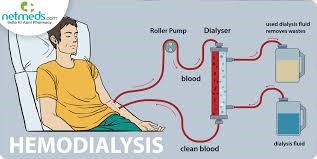Introduction to dialysis
- Dialysis is a process of removing waste and excess fluid from the blood when the kidneys are not able to do so adequately.
- It is a life-saving treatment for people with end-stage renal disease (ESRD) or acute kidney injury (AKI). There are two main types of dialysis: hemodialysis and peritoneal dialysis.
- Both types have advantages and disadvantages, and the depends on various factors such as patient preference, medical condition, availability, and cost.
- Dialysis is a life-sustaining medical procedure that serves as a vital lifeline for individuals with impaired kidney function.
- Its significance lies in its ability to replicate the essential functions of the kidneys, allowing patients to maintain a relatively normal life despite the challenges posed by kidney failure or chronic kidney disease (CKD).
- This revolutionary medical technique has transformed the landscape of nephrology, significantly enhancing the quality of life and longevity of countless patients worldwide.
- The kidneys play a critical role in filtering waste products and excess fluids from the bloodstream.
- However, when these essential organs become compromised due to various factors such as diabetes, hypertension, or genetic disorders, they lose their ability to function optimally.
- This often results in a dangerous accumulation of toxins and fluids in the body, leading to a myriad of life-threatening complications.
- Dialysis serves as an artificial means to replace the lost kidney function, ensuring that waste products are efficiently removed, and fluid balance is maintained within safe limits.

Nursing Test Bank
Naxlex Comprehensive Predictor Exams
Questions on Introduction to dialysis
Correct Answer is C
Explanation
Correct Answer is A
Explanation
Correct Answer is C
Explanation
Correct Answer is A
Explanation
Correct Answer is B
Explanation
Correct Answer is D
Explanation
Correct Answer is A
Explanation
Correct Answer is C
Explanation
Correct Answer is D
Explanation
Correct Answer is D
Explanation
Correct Answer is D
Explanation
Correct Answer is D
Explanation
Correct Answer is D
Explanation
Correct Answer is D
Explanation
Correct Answer is C
Explanation
Correct Answer is B
Explanation
Correct Answer is C
Explanation
Correct Answer is A
Explanation
Correct Answer is B
Explanation
Correct Answer is C
Explanation
Correct Answer is C
Explanation
Correct Answer is A
Explanation
Correct Answer is B
Explanation
Search Here
Related Topics
- Enteral nutrition (EN) - Genito-Urinary System Disorders
- Mobility devices: crutches, canes, continuous passive ROM machine. - Genito-Urinary System Disorders
- Bandaging - Genito-Urinary System Disorders
- IV insertion - Genito-Urinary System Disorders
- Immunodefeciency disorders - Genito-Urinary System Disorders
More on Nursing
Free Nursing Study Materials
Access to all study guides and practice questions for nursing for free.
- Free Nursing Study Trials
- Free Nursing Video tutorials
- Free Nursing Practice Tests
- Free Exam and Study Modes
- Free Nursing Revision Quizlets
